DumaTau & Little DumaTau newsletters

The Linyanti is well known for temperatures that are warm to hot at this time of year, before the summer rainy season. The temperatures recorded so far match our true month of October, and we recorded highs of 39-40° C and lows of 25° C. The most exciting news is the cooler rainy season seems to have started, and we have already had two short downpours, which quickly brought some great changes to our vegetation.
Vegetation in the Linyanti during October
Even though we did not receive much precipitation in the showers, we have seen a positive response in some plants, and the mopane trees have started producing new leaves, while the large feverberry trees are among other species also responding positively.
Birds & birding around DumaTau
Birding was outstanding this month, once again confirming that our Linyanti concession is a birder’s paradise, due to the exceptionally diverse habitat. Our guests enjoyed superb birding experiences, and at the very top of the list was a heartwarming moment with a pair of double-banded sandgrouse – both male and the female – with their three chicks out in the open plains feeding on grass seeds. What an incredible sighting that gave our guests the chance to observe tender moments of their parenting skills. The colouration of the plumage of these ground dwelling species, especially the three chicks, is remarkable for its camouflage.
Many other avian species showed up, including the yellow-billed kites, which are back and were seen often; we also ticked bateleurs, martial eagles, tawny eagles, and even special sightings of Steppe eagles were observed.
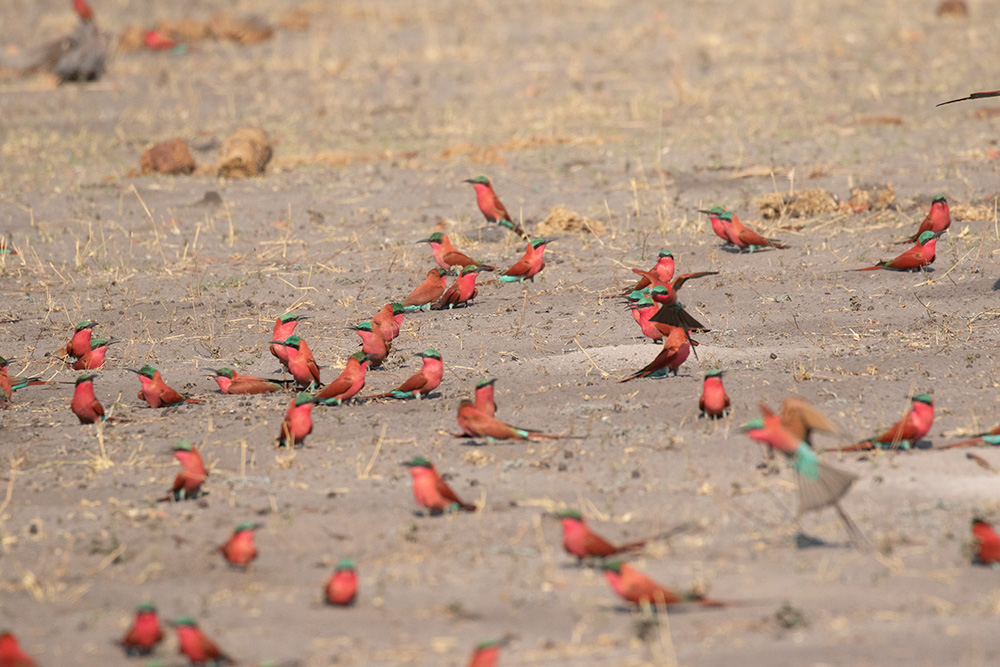
One of the most common but very interesting bird behaviours observed was between a tropical boubou and black cuckoo, where the boubou was successful in mobbing the cuckoos away from its nest in order to prevent brood parasitism. Among other avian species observed around our Linyanti River floodplains were wattled cranes, and African skimmers that were seen quite often – and believed to have been nesting on the western side of DumaTau along the river, but they have possibly moved somewhere else as we haven’t seen them for a while.
The legendary lions of the Linyanti
As lions are at the top of most safari wish lists, we are delighted to be home to many prides of lions in the Linyanti. October ended on a high note with regards to lion sightings, though the first few days of the month were less about drama, as most of the sightings were of the different prides taking it easy, and resting in the shade with full bellies during the heatwave at the beginning of the month. The following weeks were action-packed, with mostly feeding behaviour observed.
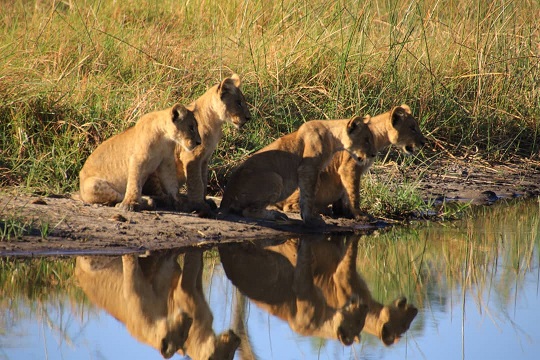
A female with four juveniles entertained our guests when they showed off their swimming skills after drinking along the channel.
Male lions chasing females is typical behaviour among these big cats, but one particularly dramatic moment was observed when one of the big males – that is believed to be nomadic – was seen chasing and fighting with our female lioness Mma Mabele. Thank goodness it was quite clear she anticipated the encounter, and the guides saw her hiding her cubs, which, even though not so small anymore, would be injured or even killed by a male in such an encounter.
A pride of 10, which is well known for specialising in hippos, was encountered with such a carcass – a most epic sighting. It is well known that lions will not put themselves at risk of significant injury by taking on large mammals which will easily injure them, but that’s not always the case in our mighty Linyanti concession. We have a history of the more numerous prides targeting the bigger mammals. With the hippo being such a large animal, the carcass kept these cats in the same location for a few days, making it possible for continuous viewing of the felids feeding, and fighting over the food.
In our open plains, the team of guides and their guests watched in awe as two female lionesses made a hunting attempt on a herd of red lechwe that were not aware of cats’ presence, as their approach was from downwind with great grass cover. The cats were so close to pouncing on one of the antelopes when the whole mission was spoilt by some blacksmith lapwings, which were disturbed from their nests on the ground, and their movement alerted the antelopes which took off.
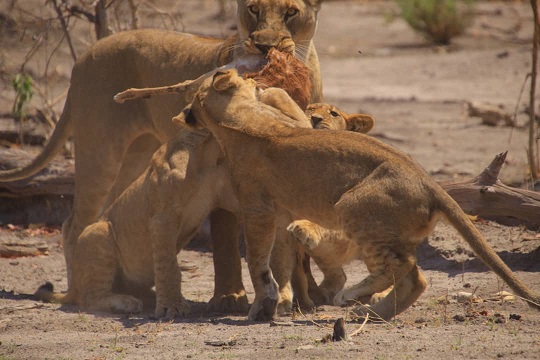
Another lion kill was spotted to the far western side of the concession. The pride had taken down a full-grown roan antelope, even though these animals are well known for fighting viciously when provoked, it was quite clear our pride was very equipped with great hunting skills and experience. In addition to these many successful hunts from our cats, a lone male lion was also spotted taking down a buffalo.
DumaTau’s leopards
There were several excellent leopard sightings in our concession this month. A lone female leopard was spotted up in a tree feeding on her impala prize, and this was followed by a sighting of a big male hunting some impala. Another special moment was when a big male and female with a cub were seen feeding on an impala.
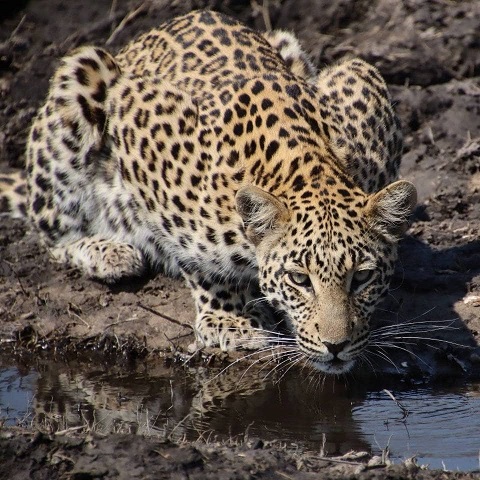
General wildlife in the Linyanti
Adding to our great sightings of the month, our general game sightings included mammals large and small. Eland were encountered in small family groups, and though they are quite skittish, they were seen quite often, especially south-east of camp.
Another extremely special addition to our sightings records were our roan antelopes, which are rare and endangered, with small, irregular areas of distribution in Africa’s savannah and wood- and grasslands. Small herds of these special species have been found along the Savuti Channel and in the mopane woodlands. Among this small group, big bulls were always visible leading the herds.
The recent first rains in our area have slightly improved our elephants’ diet. During the dry season their main food source is tree bark, especially soft bark, dry leaves, and the soft grasses along the river and channels. After the rains, we noticed a significant number of these beasts now feeding on new mopane and other tree leaves, giving our guests great opportunities to view and photograph them.
Different groups – from families to breeding herds to bachelor heads – were observed in numbers along our Savuti Channel, while our guests on the boating activities were treated to some big cows crossing the river with their young ones.
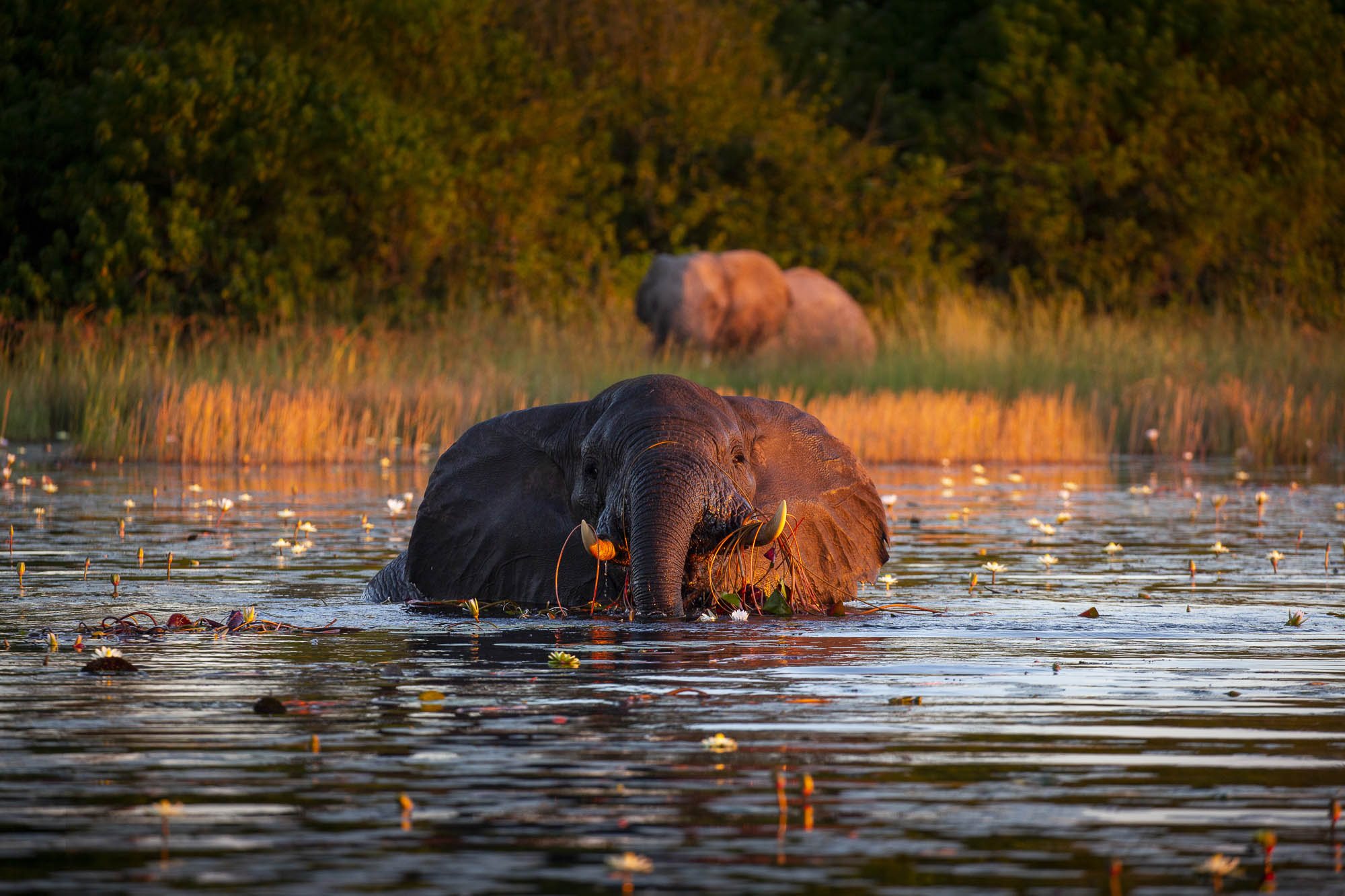
Buffalos! These large-hoofed mammals also came in numbers – showcasing lots of babies – along the channel. They were seen on many occasions submerged in the water of the Linyanti River trying to cool themselves from the scorching heat.
Staff in camp
Management Team
Lopang Rampeba – DumaTau GM
Tumisang Phala – Maintenance Manger
Joannah Mathomola – Front-of-House Manager
Mengezi Shawn Mashame – Little DumaTau
Dolly Michael – Trainee Manager
Guides
Ronald ‘Ron’ Masule
Morotsi Rodgers Kesietswe
Boikobo ‘BK’ Chinyepi
Moathodi ‘MP’ Manyenyengwa
Tom Satau
Nyatsang ‘Nas' Galebonwe


Let’s plan your next journey
Ready?
When we say we’re there every step of the way, we mean it, literally. From planning the perfect circuit, to private inter-camp transfers on Wilderness Air, and easing you through Customs. We’re with you on the ground, at your side, 24-7, from start to finish. Ready to take the road less travelled? Contact our Travel Designers to plan an unforgettable journey.